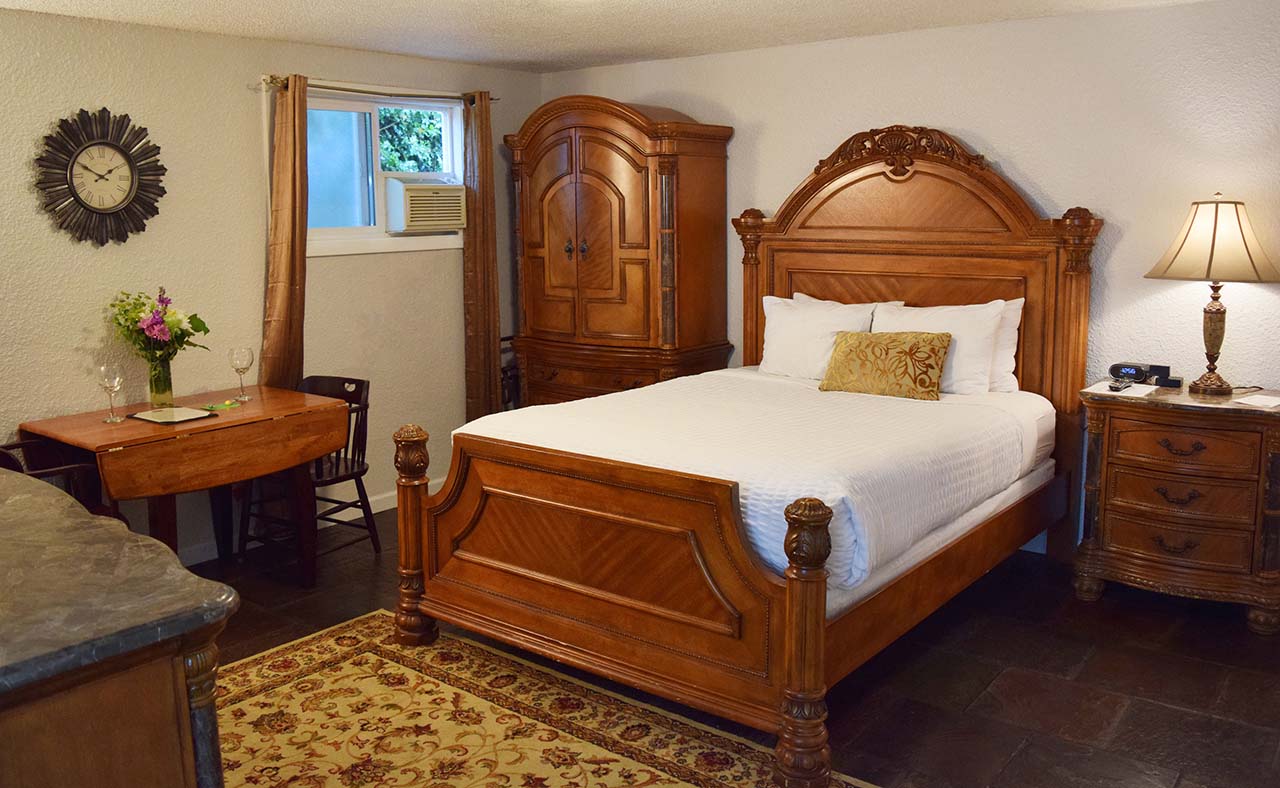
The Abiqua Room
Search Rooms
Abiqua is an Indian word given to a small river east of Silverton that flows down out of the Cascades and enters the Pudding River northwest of town. Lewis McArthur in his book “Oregon Geographical Names” says that he was unable to discover the meaning of the word. Silvertonians have just always called it “the Abiqua”, referring to the area and the creek and their source of water. Fifty years ago the Abiqua had wonderful swimming holes and was ‘the place for more than a few teen-age beer parties but mostly it was the place to cool off on a warm summer day. In the intervening years, swimming holes have given way to private development.
Room Amenities
- One Queen Bed
- No Pets Allowed
- Bathroom With Shower / Jetted Tub
- Smart TV
- WiFi Internet
- Heat / Air Conditioner
- Alarm Clock
- Coffee Maker
- Hair Dryer
Abiqua was not the name of an Indian tribe but it was the site of the last Indian battle in the Silverton area. Since no other battles are documented, it is assumed to be the only one. The Molallas were the local Indian tribe led by a chief named Coosta; they were not a warring tribe. Crooked Finger was a Molalla Indian who ended up having his name on a school, a church, a road, and the area southeast of Scotts Mills.
He got his name from an accident with a flintlock rifle. The Klamath Indians would come up over the Cascades and some of the Cayuse tribe would come down from northeastern Oregon and Washington. They would be welcomed by the Molallas and as Coosta said, they were “under my protection”. They would hunt, fish, and forage together and hold pow wows along the Abiqua or under the old oak tree that grew on Silverton’s E. Main St. until the 1880’s.
The Battle of the Abiqua lasted but a few days in March 1848; the events leading up to it took a few years. As more and more settlers moved into the area, the Indians began feeling the incursion upon their hunting and foraging territory. They began stealing a cow here and there and cutting holes in fences along with other small but irritating and frustrating acts of thievery and vandalism.
The Whitman Massacre took place in 1847 and a number of local men signed up to go fight in that Indian War which involved the Cayuses.
The settlers became more and more nervous about the actions of the local Indians. When Crooked Finger, along with a number of other Indians, burst into the home of Mrs. Miller, demanded that she cook them breakfast and then did a dance on her kitchen table, the settlers decided they had to take a stand.
There were a number of versions of the battle in the following decades. As with all events, different people observed different things and came away with different interpretations and memories. The actual fighting was done between the ‘home guard’, local pioneer men who had formed their own militia, and the Klamaths. In the end, 10-13 Indians were killed, depending on whose version is read, and one Indian woman was wounded. Most of the reports said that the Klamath women fought right alongside their men. One white man was killed. The Klamaths left for their own lands, never to return, which was one of the main goals according to an account of the incident by John Warnock. He was involved in the whole business and wrote his own version of what happened. Warnock, who had learned the Chinook language, was often asked to interpret between the Indians and the white man. He was respected and feared by the Molallas. Another esteemed version of the battle can be found in a whole chapter of the book “History of the Silverton Country” by Robert Horace Downs.
The Abiqua area was settled in the late 1840’s by men like John Warnock, Richard Miller, Samuel Allen, Mitchell Whitlock, Lauren Thomas, among others. The one with a colorful and interesting background is Warnock.
John Francis Warnock was born in or near Glasgow, Scotland. One source gives his birth year as 1786 and another lists it as 1816. He did attend college but which one is unknown. When he withdrew from college he apprenticed himself as a sailor, eventually gaining a commission as the captain of a trading schooner. He served sixteen years in the British Merchant Marines, however, no record exists of his sailings. It is known that he became skilled in languages and diplomacy. When he sailed for San Francisco on a Russian trading ship, he was shipwrecked off Baja.
He eventually made his way to the Oregon Territory, taking a Donation Land Claim in Yamhill Country in 1843. One report says that he traded this land for a mule and moved to Clackamas County. There are also reports that he lived for a time in Portland making shingles. In 1845 he married Mary Frances Halley, 14, who had come with her family on the first wagon train of Dr. Whitmans in the early 1840’s. John and Mary took up a claim of 640 acres on the Abiqua River. He became a U.S. citizen in 1854. The McLoughlin School District was established on Warnock land circa 1870. He died Nov. 4, 1885 and is buried in the Miller Cemetery, close to the Abiqua.
Richard Miller was born in Maryland in 1802 and arrived in the Abiqua area in the fall of 1847 with his wife and ten of his children. He filed for a Donation Land Claim of 640 acres and built his home just north of what would eventually be the Miller Cemetery. Margot Miller writes that during the Indian War, “the Miller home was both a refuge for neighbors and a central location for parleys between the pioneers and the Molalla/Klamath Indians. The Indians called him “hyas tyee”, a term denoting respect.”
By the spring of 1850, he had been elected to the Territorial Council representing Marion County. “Uncle Dickey Miller of the Abiqua” was a Marion County Commissioner in succeeding years and in 1857 he was elected to serve on a committee to help write the constitution for Oregon which would become a state in 1859.
He deeded land for the Miller Cemetery and requested that a church be built that would be free and open to all denominations. His first wife Margaret Stanton Miller died in 1856 and is buried there. Ironically, when he passed away in 1872 he was buried in a Miller Cemetery, but it is in Linn County where he had gone to live with a daughter.
The church was finally built in 1882 and is surrounded by the Miller Cemetery where hundreds of the Abiqua pioneers are buried. One of the reasons for having the church built was so that the residents of the Abiqua community would not have to travel very far between funeral services and the cemetery. The church still stands and is on the National Register of Historic Places thanks to the efforts of Miller descendants.
Sources include “Oregon Geographical Names” by Lewis McArthur; “Warnock Family Notes” compiled by Carol Roller; “When Silverton Was Young”, John Warnock Family by Flora Hoblitt; “War on the Abiqua” as told by John Warnock and published in the “Everything’s Fine-0 in Mulino,” Apr/May 1991; Chap 6 in “History of the Silverton Country” by Robt. Downs; and “Miller church 1882-1982” by Margot Miller.

